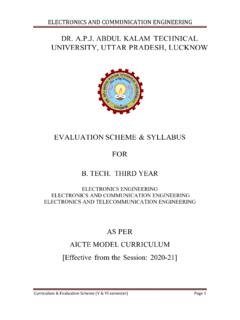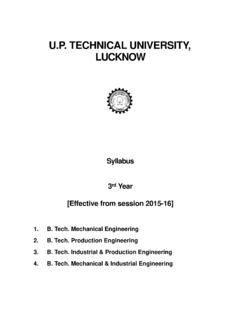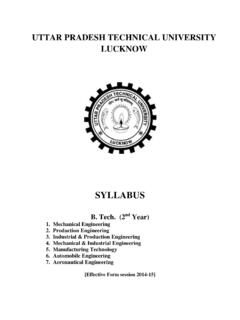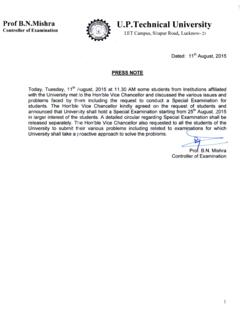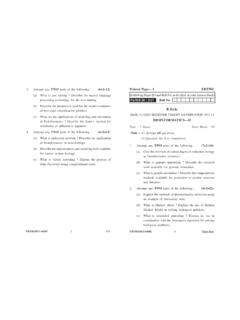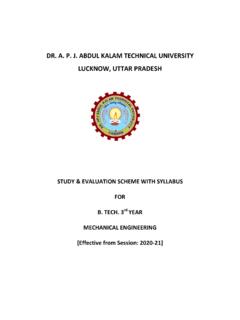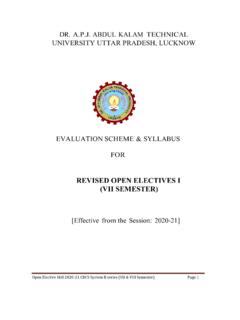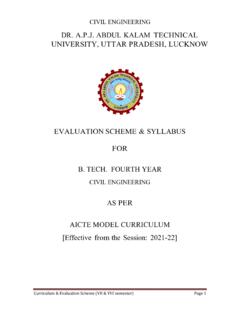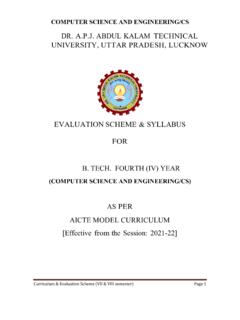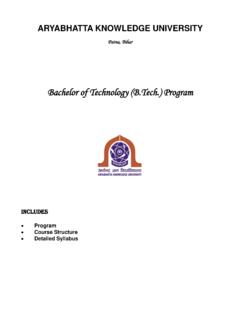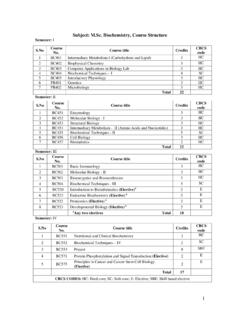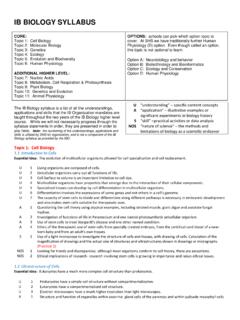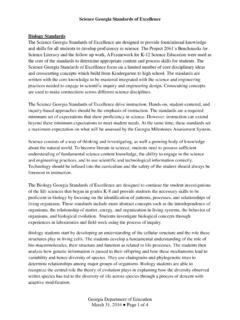Transcription of EVALUATION S CHEME & SYLLABUS FOR
1 Note Open E DR e: 1. The Stustudied 2. * It is TraineOElective List R. shall cthe same coumandatory ted Faculty (wOPEN EII (VII Semes. ABDUUTALUATOPAICT[Effectchoose an opeurse in any fthat for thesewho had doneELECTIV ster) 2021-2UL KALTTAR PTION SCPEN ELEATE MODtive fromen Elective fform during e subjects (Ke the FDP foVES II L22 LAM TEPRADECHEMEFOR ECTIVESS PER DEL CUm the Sfrom the list the degree pKOE069, KOEor these courLIST 20 ECHNIESH, LU E & SYLS II LIST URRICUS ession:2in such a , KOE08rses) will teac021-22 ICAL UUCKNOLLABU ULUM 2021-22anner that h 87,KOE097 ch the coursPageUNIVEROW US 2] he/she has no& KOE098) ses. e 1 RSITY ot only OPEN ELECTIVES II LIST 2021-22 Open Elective List II (VII Semester) 2021-22 Page 2 VII Semester (2021-22) OPEN ELECTIVE-II KOE071 FILTER DESIGN KOE072 BIOECONOMICS KOE073 MACHINE LEARNING KOE074 RENEWABLE ENERGY RESOURCES KOE075 OPERATIONS RESEARCH KOE076 VALUE RELATIONSHIP & ETHICAL HUMAN CONDUCT- FOR A HAPPY & HARMONIOUS SOCIETY KOE077 DESIGN THINKING KOE078 SOIL AND WATER CONSERVATION ENGINEERING KOE078 INTRODUCTION TO WOMEN S AND GENDER STUDIES OPEN ELECTIVES II LIST 2021-22 Open Elective List II (VII Semester) 2021-22 Page 3 KOE-071 FILTER DESIGN 3L:0T:0P 3 Credits course OBJECTIVE: Students undergoing this course are expected to: 1.
2 Understand about the characteristics of different filters. 2. Understand the concept of Approximation Theory. 3. Learn about the switched capacitor filter. course OUTCOME: After completion of the course student will be able to: CO1 Choose an appropriate transform for the given signal. CO2 Choose appropriate decimation and interpolation factors for high performance filters. CO3 Model and design an AR system. CO4 Implement filter algorithms on a given DSP processor platform. Unit Topics Lectures I Introduction: Fundamentals, Types of filters and descriptive terminology, why we use Analog Filters, Circuit elements and scaling, Circuit simulation and modelling. Operational amplifiers: Op-amp models, Op-amp slew rate, Operational amplifiers with resistive feedback: Noninverting and Inverting, Analysing Op-amp circuits, Block diagrams and feedback, The Voltage follower, Addition and subtraction, Application of Op-amp resistor circuits.
3 8 II First order filter: Bilinear transfer functions and frequency response Bilinear transfer function and its parts, realization of passive elements, Bode plots, Active realization, The effect of A(s), cascade design. 8 III Second order low pass and band pass filters: Design parameters, Second order circuit, frequency response of low pass and band pass circuits, Integrators and others biquads. 8 IV Second order filters with arbitrary transmission zeros: By using summing, By voltage feed forward, cascade design revisited. Low pass filters with maximally flat magnitude: the ideal low pass filter, Butterworth response, Butterworth pole locations, low pass filter specifications, arbitrary transmission zeros. 8 V Low pass filter with equal ripple (Chebyshev) magnitude response: The chebyshev polynomial ,The chebyshev magnitude response, Location of chebyshev poles, Comparison of maximally flat & equal ripple responses, Chebyshev filter design Inverse chebyshev and cauer filters: Inverse chebyshev response, From specifications to pole and zero locations, Cauer magnitude response, Chebyshev rational functions, Cauer filter design.
4 8 Text Book: 1. Rolf. Schaumann, Haiqiao Xiao, Mac. E. Van Valkenburg, Analog Filter Design , 2ndIndian Edition, Oxford University Press. Reference Books: 1. J. Michael Jacob, Applications and Design with Analog Integrated Circuits , Second edition, Pearson. 2. T. Deliyannis, Yichuang Sun, Fidler, Continuous-Time Active Filter Design ,CRC Press. OPEN ELECTIVES II LIST 2021-22 Open Elective List II (VII Semester) 2021-22 Page 4 KOE-072 BIOECONOMICS 3L:0T:0P 3 Credits OBJECTIVE: This course is designed with an objective to provide an understanding of the basic knowledge of bioecomics to students so that they can explore entrepreneurship opportunities in the bio based industry. This course also serves interdisciplinary innovation in terms of sustainable bioeconomy course OUTCOME: After completion of the course student will be able to: 1.
5 Students will be able to understand basic concept of Bioeconomics, challenges, opportunities& regulations 2. Students will be able to understand development and innovation in terms of bioeconomy towards sustainable development 3. Students will be able to understand Inter- and transdisciplinarity in bioeconomy &research approaches 4. Students will be able to explain biobased resources ,value chain, innovative use of biomass and biological knowledge to provide food, feed, industrial products Unit Topics Lectures I Introduction: Fundamentals, Types of filters and descriptive terminology, why we use Analog Filters, Circuit elements and scaling, Circuit simulation and modelling. Operational amplifiers: Op-amp models, Op-amp slew rate, Operational amplifiers with resistive feedback: Noninverting and Inverting, Analysing Op-amp circuits, Block diagrams and feedback, The Voltage follower, Addition and subtraction, Application of Op-amp resistor circuits.
6 8 II Economic Growth, Development, and Innovation in terms of bioeconomy, Environmental Economics and the Role of Government, Modelling and Tools Supporting the Transition to a Bioeconomy, Role of biobased Economy in sustainable development. 8 III Inter- and transdisciplinarity in Bioeconomy &research approaches, primary production, processing of biobased resources,Markets, Sustainability Management and Entrepreneurship in biobased products. 8 IV Biobased Resources and Value Chains, Processing of Biobased Resources, Markets, Sustainability Management and Entrepreneurship opportunity in biobased product. Food Security and Healthy Nutrition in the Context of the Bioeconomy, Use of Biomass for the Production of Fuel and Chemicals, The importance of Biotechnology for the Bioeconomy. 8 V sustainable and innovative use of biomass and biological knowledge to provide food, feed, industrial products, bioenergy and ecological services, importance of bioeconomy-related concepts in public, scientific, and political discourse, Dynamic Management of Fossil Fuel, Biofuel.
7 8 Text Book: 1. Principles of Bioeconomics by I. Sundar, Vedams eBooks (P) Ltd New Delhi, India 2. Bioeconomy:Shaping the Transition to a Sustainable, Biobased Economy by Iris Lewandowski, Springer. 3. Sociobiology and Bioeconomics by Koslowski, Peter 4. Modeling, Dynamics, Optimization and Bioeconomics I, by Pinto, Alberto Adrego, Zilberman, David, Springer. OPEN ELECTIVES II LIST 2021-22 Open Elective II 2021-22 K series (VII Semester) Page 5 KOE-073 MACHINE LEARNING 3L:0T:0P 3 Credits Unit Topics Lectures I INTRODUCTION Well defined learning problems, Designing a Learning System, Issues in Machine Learning; THE CONCEPT LEARNING TASK - General-to-specific ordering of hypotheses, Find-S, List then eliminate algorithm, Candidate elimination algorithm, Inductive bias.
8 8 II DECISION TREE LEARNING - Decision tree learning algorithm-Inductive bias- Issues in Decision tree learning; ARTIFICIAL NEURAL NETWORKS Perceptrons, Gradient descent and the Delta rule, Adaline, Multilayer networks, Derivation of backpropagation rule Backpropagation AlgorithmConvergence, Generalization. 8 III Evaluating Hypotheses: Estimating Hypotheses Accuracy, Basics of sampling Theory, Comparing Learning Algorithms; Bayesian Learning: Bayes theorem, Concept learning, Bayes Optimal Classifier, Na ve Bayes classifier, Bayesian belief networks, EM algorithm. 8 IV Computational Learning Theory: Sample Complexity for Finite Hypothesis spaces, Sample Complexity for Infinite Hypothesis spaces, The Mistake Bound Model of Learning; INSTANCE-BASED LEARNING k-Nearest Neighbour Learning, Locally Weighted Regression, Radial basis function networks, Case-based learning.
9 8 V Genetic Algorithms: an illustrative example, Hypothesis space search, Genetic Programming, Models of Evolution and Learning; Learning first order rules- sequential covering algorithms-General to specific beam search-FOIL; REINFORCEMENT LEARNING - The Learning Task, Q learning. 8 Text Book: 1. Tom M. Mitchell, Machine Learning, McGraw-Hill Education (India) Private Limited, 2013. 2. Ethem Alpaydin, Introduction to Machine Learning (Adaptive Computation and Machine Learning), The MIT Press 2004. 3. Stephen Marsland, Machine Learning: An Algorithmic Perspective, CRC Press, 2009. 4. Bishop, C., Pattern Recognition and Machine Learning. Berlin: Springer- Verlag. OPEN ELECTIVES II LIST 2021-22 Open Elective II 2021-22 K series (VII Semester) Page 6 KOE-074 RENEWABLE ENERGY RESOURCES 3L:0T:0P 3 Credits Unit Topics Lectures I Introduction: Various non-conventional energy resources- Introduction, availability, classification, relative merits and demerits.
10 Solar Cells: Theory of solar cells. Solar cell materials, solar cell array, solar cell power plant, limitations. 8 II Solar Thermal Energy: Solar radiation, flat plate collectors and their materials, applications and performance, focussing of collectors and their materials, applications and performance; solar thermal power plants, thermal energystorage for solar heating and cooling, limitations. 8 III Geothermal Energy: Resources of geothermal energy, thermodynamics of geo- thermal energy conversion-electrical conversion, non-electrical conversion, environmental considerations. Magneto-hydrodynamics (MHD): Principle of working of MHD Power plant, performance and limitations. Cells: Principle of working of various types of fuel cells and their working, performance and limitations. 8 IV Thermo-electrical and thermionic Conversions: Principle of working, performance and limitations.
